The Imaging Resource
First Look Review
Sony Cyber-shot DSC-T5 Digital Camera
| Camera QuickLook | ||
| Review Date |
|
|
| User Level |
|
|
| Product Uses |
|
|
| Digicam Design |
|
|
| Picture Quality |
Very Good, 5.1-megapixel CCD | |
| Print Sizes |
11x17s, or 8x10s with heavy cropping | |
| Availability |
September 9, 2005 | |
| Suggested Retail Price |
|
|
Introduction
|
||||||||
Sony cameras offer excellent features and performance, good build quality and great picture quality. Sony currently offers no fewer than five distinct lines of cameras, spanning an incredible range of features, price, and performance. In their "Compact" line, they've now added a new five-megapixel model that builds on the success of the preceding T1 model. With a 3x optical zoom lens, compact design, and very generous 2.5-inch LCD screen, the new DSC-T5 is about the thickness of a ladies' compact and very pocket friendly. Automatic exposure control offers point-an-shoot ease, with a handful of scene modes for more difficult shooting situations.
Modeled in the same sleek style as preceding Sony Cyber-shot T-series models, the DSC-T5 is ultra thin and compact, like a small makeup case. The camera's thin profile is chic and attractive, with smooth panels and very few protrusions. A horizontal sliding lens cover is a unique twist on the typical lens cover design, and doubles as a finger rest when open. The T5 has a vertical lens design (similar to what we've seen on Minolta's Dimage X series digital cameras), which eliminates any lens protrusion on the front panel. With its diminutive size, the DSC-T5 is definitely pocket friendly and travel-worthy. The biggest feature on the DSC-T5 is its large, 2.5-inch color LCD monitor, which takes up most of the camera's rear panel. Though small, and ultimately a point-and-shoot style digital camera, the DSC-T5 doesn't skimp on features, offering a 3x optical zoom lens with a range of focus options, a 5.1-megapixel CCD for high-resolution images, and a host of preset shooting modes and exposure options.
The DSC-T5 is equipped with a Carl Zeiss Vario Tessar 3x, 6.7-19.0mm lens, equivalent to a 38-114mm lens on a 35mm camera. (A fairly standard zoom range, going from an average wide angle to a good telephoto.) Normal focus ranges from approximately 1.6 feet (0.5 meters) to infinity, with a Macro setting that lets you get within 3.1 inches (8 centimeters) when the lens is zoomed to its wide angle position. A Magnifying Glass scene mode (described below) gets even closer, focusing as close as one centimeter (though it also uses digital zoom to enlarge detail). In addition to automatic focus control, the DSC-T5 offers a range of fixed focus settings through the Record menu, as well as Center AF, Spot AF, and Multi AF focus area options. (Spot AF reads from the very center of the frame, and Center AF from a larger area at the center.) Through the camera's Setup menu, you can also select Single or Monitoring AF modes. (Monitoring mode adjusts focus continuously.) An AF illuminator lamp on the front of the camera helps focus at low light levels, a very handy feature I wish more digicam manufacturers would add to their cameras. In addition to the camera's 3x optical zoom, the DSC-T5 offers a maximum of 2x Precision Digital Zoom. Sony's Precision Digital Zoom does an excellent job of minimizing loss of quality. There's also an option to use Sony's Smart Zoom digital zoom up to 4x, which enlarges images with less distortion than the traditional digital zoom (not available at the max resolution setting). Still, true optical zoom is always preferable for the best quality, as digital zoom simply enlarges the center portion of the CCD, resulting in lower resolution and softer detail. The 2.5-inch LCD monitor is the only viewfinder, and the generous size definitely helps with framing. The informative display reports a variety of camera settings (including aperture and shutter speed when the Shutter button is halfway pressed), and features a live histogram display in both Playback and Record modes.
Exposure is automatically controlled on the DSC-T5, great for novices and casual users looking for simplicity. However, a range of preset Scene modes is available, as well as a handful of adjustable exposure options. An On/Off button on top of the camera powers the camera on (as does the sliding lens cover), and a Mode switch directly adjacent selects between Playback, Record, and Movie modes. Within Record mode, you can select Automatic, Program AE, Twilight, Twilight Portrait, Soft Snap, Landscape, Snow, Beach, Fireworks, High Speed Shutter, Candle, and Magnifying Glass exposure modes. The Automatic setting takes away all user control, with the exception of flash, macro, and resolution. Program AE mode keeps exposure control automatic, but you now have control over all other exposure variables. Both Twilight modes optimize the camera for low-light shooting by allowing shutter times as long as two seconds, while Soft Snap mode enhances skin tones and softens the subject slightly for flattering portraits. Landscape mode sets the camera up for shooting broad vistas. Snow mode enhances saturation to prevent loss of color in bright white snowscapes, while Beach mode ensures that blue tones are recorded accurately in lakeside or seaside photos. Fireworks mode preserves color by using a slower shutter speed to capture the full display. High Speed Shutter mode is best for moving subjects, and uses faster shutter speeds to freeze action, while Candle mode preserves color in candlelight and soft incandescent lighting. Finally, Magnifying Glass mode magnifies the subject on the LCD display up to 3x (a separate function from Macro mode), focusing on subjects as close as one centimeter. However, keep in mind that this mode also employs the digital zoom function, which may degrade image quality slightly.
Although the camera controls aperture and shutter speed, it does report both settings on the LCD information display, so you have an idea of what the exposure will be. By default, the camera uses a Multi metering system to determine the exposure, which takes readings from throughout the frame. However, Spot and Center metering modes are also available through the Record menu. You can increase or decrease the overall exposure from -2 to +2 exposure equivalents (EV), and sensitivity is adjustable to 64, 100, 200, or 400, with an Auto setting as well. When shooting at slower shutter speeds or higher ISO settings, the DSC-T5 automatically enables a Noise Reduction system to eliminate excess image noise. The DSC-T5 offers Saturation, Sharpness, and Contrast adjustments, as well as a Picture Effects setting that lets you record images in black and white or sepia monotones. White Balance options include an Auto setting, as well as Daylight, Cloudy, Fluorescent, Incandescent, and Flash modes. The DSC-T5's flash operates in Forced, Suppressed, Auto, Red-Eye Reduction, and Slow-Sync modes.
In Movie exposure mode, the camera captures either 640 x 480-, or 160 x 112-pixel resolution moving images with sound for as long as the memory card has available storage space. At the 640 x 480 setting, you can choose between Standard and Fine quality options. Standard records at 16 frames per second, while Fine records at 30 frames per second and requires the Memory Stick PRO Duo media. Through a Record menu option, the DSC-T5 also offers a Multi Burst mode, which captures an extremely rapid 16-frame burst of images, at a selectable rate of 7.5, 15, or 30 frames per second. Multi Burst shots are played back as a slow-motion animation on the camera, but appear as a single large file with 16 sub-images in it when viewed on a computer. (This is a useful tool for analyzing golf and tennis swings.) The same menu option also offers Exposure Bracketing and Burst options. Exposure Bracketing mode captures a series of three images at different exposure settings, and you can set the exposure variance step size. Burst mode works like a motor drive on a traditional 35mm camera, capturing a maximum of nine images in quick succession at the highest resolution. A Self-Timer mode provides a 10-second delay between the time the Shutter button is pressed and the time that the camera actually takes the picture, giving the photographer time to run around and get into the picture.
The DSC-T5 stores images on its 32MB internal memory, or on Sony Memory Stick Duo and Memory Stick PRO Duo memory cards, available separately in capacities as large as 2GB. Since the camera doesn't come with a Memory Stick, I'd recommend purchasing a larger capacity card so you don't miss any shots. For power, the DSC-T5 uses a single NP-FT1 Info-Lithium battery pack, which accompanies the camera, along with the necessary charger. An included multi-use USB / A/V cable comes with the camera, and connects the camera either to a computer or television. A software CD is loaded with Pixela Image Mixer software and USB drivers, for downloading and organizing images.
Basic Features
- 5.1-megapixel CCD.
- 2.5-inch color LCD monitor.
- Carl Zeiss Vario Tessar 3x zoom lens, equivalent to 38-114mm on a 35mm camera.
- Maximum aperture of f/3.5 - f/4.4, depending on lens zoom position.
- As much as 2x Precision Digital Zoom, and as much as 4x Smart Zoom.
- Automatic and Program exposure control.
- Shutter speeds from 1/1,000 to 1/8 second.
- Built-in flash with four modes.
- 32MB internal memory.
- Memory Stick Duo and Memory Stick PRO Duo image storage (card not included).
- USB / A/V combo cable included for connection to television or computer.
- Power supplied by rechargeable NP-FT1 Info-Lithium battery (battery and charger supplied).
- Picture Package, Pixela Image Mixer, and Cyber-shot Life tutorial software and USB drivers included for both Windows and Mac platforms.
Special Features
- MPEG VX Movie mode.
- Twilight, Twilight Portrait, Soft Snap, Landscape, Snow, Beach, Fireworks, High Speed Shutter, Candle, and Magnifying preset scene modes.
- 10-second Self-Timer for delayed shutter release.
- Picture Effects menu with Black-and-White and Sepia color options.
- Macro (close-up) lens setting.
- White balance (color) adjustment with six modes.
- Burst, Multi Burst, and Auto Exposure Bracketing record modes.
- Multi-Pattern and Spot metering modes.
- Sensitivity setting with four ISO equivalents (64, 100, 200, 400) and an Auto setting.
- Five-area Multi-Point auto focus with Spot and Center AF modes, and AF illuminator.
- Single and Monitoring AF modes.
- Automatic Noise Reduction for longer exposures.
- DPOF (Digital Print Order Format) compatibility.
- PictBridge, PRINT Image Matching III, and Exif Print compatible.
Recommendation
Though it has impressive specs, the T5 really isn't that different from past T-series offerings, including the Sony T33, on the market concurrently. The camera's 3x Carl Zeiss zoom lens, large LCD monitor, and 5.1-megapixel CCD are great, though, as are the camera's available Scene exposure modes and handful of creative effects options. The T5 looks like another excellent offering from Sony that is just slightly lighter than the T33, and has a nice, streamlined slider on the front.
Small and very compact, the DSC-T5 is mostly a cosmetic redesign to the already sleek and stylish T-series of the Sony Cyber-shot line. The camera's thin dimensions and large LCD panel are slightly restyled as is the horizontal lens cover that slides up and down. Because the camera has a vertically-oriented lens, the front panel remains smooth at all times, and very pocket friendly. Measuring 3.7 x 2.4 x 0.8 inches (94 x 60 x 20 millimeters), the DSC-T5 will definitely fit into shirt pockets and tiny evening bags. Though it sports an all-metal body, the DSC-T5 is still light weight, at just 4.8 ounces (137 grams) with battery and memory card.
The front of the DSC-T5 is nearly flat, except for a slight protrusion from the sliding lens cover. (The lens cover acts as a power switch as well, though the camera does feature a separate Power button.) Because the lens design is all-internal, it doesn't telescope outward when the camera is powered on. Instead, the lens lines up vertically, using a mirror to reflect the view. This also makes the camera quick on the draw, as you don't have to wait on the lens to telescope into position before you can shoot. Also beneath the lens cover are the flash and self-timer / AF illuminator lamp. There isn't much of a handgrip on the DSC-T5, though the lens cover's top edge acts as a small ledge for fingers to grasp.
The right side of the DSC-T5 features a small eyelet for attaching the wrist strap and the battery / media compartment. The shiny silver door slides forward before opening outward, and reveals the battery and Memory Stick slots.
The opposite side of the camera is featureless.
The DSC-T5's top panel is also fairly smooth, with hardly any protrusions from the few controls. The Shutter button dominates the right corner, followed by the Mode Switch and Power button directly to the left. A small microphone is on the far left. Angled down from the top panel toward the rear of the camera is the tiny flash LED, indicating the current status of the flash.
The remaining few camera controls are on the back panel, along with the very large, 2.5-inch LCD monitor. A set of raised circles provides a slight thumb grip, and overlays the camera's small speaker. A zoom control is in the top right corner, with the Five-way Arrow pad next to the lower right corner of the LCD monitor. The Display, Menu, and Resolution / Erase buttons line up down the right side of the LCD monitor.
The DSC-T5 has a slightly tapered bottom panel, which holds the USB / A/V connector jack and a metal tripod mount.
The DSC-T5's user interface is straightforward, with a layout that's simple to navigate. The DSC-T5 has only a few external controls, as most of the exposure options are accessed through the LCD menu system. The camera's Five-way Arrow pad keys serve multiple functions, and you can quickly change the camera mode via the Mode switch on the top panel. The arrow keys of the Five-way pad scroll through menu selections, and the OK button in the center of the pad confirms any changes. The menu system is so simple and intuitive I think even novice users will be able to become completely familiar with it in an hour or less.
Record Mode Display: The DSC-T5's LCD monitor reports a fair amount of camera information in Record mode, including the battery level and approximate operating time left, image resolution and quality, exposure mode, flash mode, autofocus mode, and any other basic settings. A set of focus brackets is in the center of the frame. A half-press of the Shutter button adds the shutter speed and aperture settings to the display. The Display button cycles through a range of display modes, enabling a histogram, as well as eliminating the information overlay (with the exception of the focus brackets and mode).
Playback Mode Display: In Playback mode, the LCD monitor reports basic information such as the image resolution, battery level and time, folder number, image series number, file name, and the date and time the image was captured. Pressing the Display button enables an expanded information display with basic exposure information and a small histogram. You can also cancel the information display entirely, by pressing the Display button a third time.
External Controls
Sliding Lens Cover: Stretching across the width of the camera's front panel, this cover slides up and down to reveal or conceal the lens. Though the camera has a Power button, this sliding cover also controls the camera's power.
Shutter Button: Located on the far right side of the top panel, this button sets focus and exposure when halfway pressed, and fires the shutter when fully pressed.
Mode Switch: This switch is immediately left of the Shutter button, though the indicator icons line up below it on the rear panel. The following options are available:
- Playback: Replays captured still images and movie files, with options for image management and printing.
- Record: Places the camera in still Record mode, with a handful of preset scenes and Auto and Program AE modes available.
- Movie: Records moving images with sound, for as long as the memory card has space.
Power Button: To the left of the Mode switch, this button turns the camera on and off.
Zoom Rocker Button: Located in the top right corner of the back panel, this rocker switch controls the optical and digital zoom in any record mode.
In Playback mode, this button controls the digital enlargement of captured images and accesses the index display mode as well as a detailed information display. (The "T" side zooms in, the "W" side zooms out. Zooming out from the normal-sized single image view brings up an index display of tiny "thumbnail" images.)
Display Button: Adjacent to the upper right corner of the LCD display, this button controls the LCD monitor's display mode. In both Record and Playback modes, the button cycles through the image and information displays.
Menu Button: Below the Display button, this button displays or dismisses the settings menu in any Record mode or in Playback mode.
Image Size / Erase Button: Adjacent to the lower left corner of the LCD monitor, this button activates the Image Size setting in any Record mode. In any still image mode, resolution options of 5M (2,592 x 1,944 pixels); 3:2 (2,592 x 1,728 pixels); 3M (2,048 x 1,536 pixels); 1M (1,280 x 960 pixels); VGA E-Mail (640 x 480 pixels); and 16:9 HDTV (1,920 x 1,080 pixels) are available. Movie mode options include 640 x 480 (Standard), 640 x 480 (Fine), and 160 x 120 pixels. (The 640 x 480 Fine option is only available when using the Memory Stick PRO Duo media format.)
In Playback mode, this button pulls up the single erase menu, letting you delete the currently displayed image. Pressing this button in Index display mode gives you the option of deleting all files in the folder.
Five-way Controller: In the lower right corner of the rear panel, this five button control pad features four arrow keys and a center "OK" button. The arrow keys navigate through any settings menu, and the OK button confirms menu selections.
In Record mode, the up arrow controls flash mode, cycling through Auto, Forced, Suppressed, and Slow-Sync modes. The down arrow activates the Self-Timer option, while the right arrow controls the Macro mode. The left arrow calls up a quick review of the most recently-captured image.
In Playback mode, the left and right keys scroll through captured images on the memory card. When an image has been enlarged, all four arrow keys move around within the enlarged view.
Camera Modes and Menus
Record Mode: In this mode, the camera captures standard still images, controlling aperture and shutter speed. Pressing the Menu button displays the Record settings menu, with options varying depending on the exposure mode selected:
Camera: Offers Automatic, Program AE, Twilight, Twilight Portrait, Soft Snap, Landscape, Snow, Beach, Fireworks, High Speed Shutter, Candle, and Magnifying Glass exposure modes. The mode selected dictates which of the following options are available. Program mode offers all of the following.
- Exposure Compensation: Increases or decreases exposure from -2 to +2 exposure equivalents (EV) in one-third step increments.
- Focus: Changes the focus area to Multi AF, Spot AF, or Center AF, or selects from a range of fixed focus settings (0.5, 1.0, 3.0, or 7.0 meters, or Infinity).
- Metering: Sets the metering mode to either Spot, Center, or Multi metering.
- White Balance: Sets the color balance to Auto, or adjusts for Daylight, Cloudy, Fluorescent, Incandescent, or Flash light sources.
- ISO: Sets the camera's sensitivity to Auto, or to 64, 100, 200, or 400 ISO equivalents.
Picture Quality: Sets the JPEG compression level to Fine or Standard.
- Mode: Changes the recording mode to Normal, Burst, Exposure Bracketing, or Multi Burst modes.
- Bracket Step: (Only available if Exposure Bracketing is selected above.) Sets the level of exposure variation for Auto Exposure Bracketing shots. Step sizes include 1.0, 0.7, or 0.3 EV.
- Interval: (Only available in Multi Burst mode.) Specifies the shutter interval for Multi Burst mode. Options are 1/7.5, 1/15, or 1/30.
- Flash Level: Adjusts the flash intensity to Normal, Low, or High.
- Picture Effects: Applies either Black and White or Sepia color effects.
Saturation: Adjusts the overall color saturation, with High, Normal, and Low options.
- Contrast: Controls the level of contrast in images, with options for High, Normal, and Low.
- Sharpness: Adjusts the in-camera sharpening. Options are High, Normal, and Low.
Playback Mode: This mode lets you review captured images on the memory card, erase them, protect them, set them up for printing, etc. When playing back movie files, you can also opt for "frame-by-frame" playback, which plays back the movie file slowly, several frames at a time. Pressing the Menu button displays the following options:
Folder: Selects the folder of images to be played back.
- Protect: Write-protects the current image, or removes protection.
- DPOF: Marks the current image for printing on a DPOF device, or removes the print mark.
- Print: Enables direct printing to a connected device.
- Slide: Enables a slide show of all images captured on the Memory Stick Duo. You can control the interval between each image, the range of images to be played back, and whether or not the slide show repeats.
- Resize: Resizes the current image to one of the available resolution sizes.
Rotate: Rotates the current image 90 degrees clockwise or counterclockwise.
- Divide: Divides movie files into segments, providing a very basic editing tool you can use to "trim" your movies to just the portion you want to keep.
- Trimming: Lets you crop a portion of an image, enlarge it, and save it as a separate file.
Movie Mode: Records short movie clips with sound, for as long as the Memory Stick has available space. The LCD menu system offers the following options:
- Exposure Compensation: Increases or decreases exposure from -2 to +2 exposure equivalents (EV) in one-third step increments.
- Focus: Changes the focus area to Multi AF, Spot AF, or Center AF, or selects from a range of fixed focus settings (0.5, 1.0, 3.0, or 7.0 meters, or Infinity).
- Metering: Sets the metering mode to either Spot, Center, or Multi metering.
- White Balance: Adjusts the color balance for Auto, Daylight, Cloudy, Fluorescent, or Incandescent light sources.
- Picture Effects: Applies either Black and White or Sepia color effects.
Set-Up Mode: The following four-page Set-Up menu is available in Playback, Record, and Movie modes, as an extension of the LCD menu:
- Camera 1:
AF Mode: Sets the autofocus to Single or Monitor modes. (Monitor mode automatically adjusts the focus before the Shutter button is pressed or held halfway.)
- Digital Zoom: Enables Smart Zoom or Precision Digital Zoom, or turns digital zoom off entirely.
- Date/Time: Controls the date and time display, options are Day & Time, Date, or Off.
- Red-Eye Reduction: Enables the Red-Eye Reduction flash (which will fire with all flash modes), or turns it off.
- AF Illuminator: Puts the AF Illuminator into Auto mode, or simply turns it off.
- Auto Review: Activates the Auto Review function, which automatically displays the most recently captured image post-capture.
- Camera 2:
Enlarged Icon: If activated, this option temporarily enlarges the icon display in the LCD monitor whenever flash mode, macro mode, etc. is adjusted.
- Internal Memory Tool
- Format: Formats the internal memory, erasing all files (even protected ones).
- Memory Stick Tool
Format: Formats the Memory Stick DUO card, if inserted, erasing all files (even protected ones).
- Create Rec. Folder: Creates a new folder for recording images.
- Change Rec. Folder: Changes the folder that images are recorded to.
- Copy: Copies all images from the internal memory to the Memory Stick.
- Setup 1
LCD Backlight: Controls the LCD backlight feature, setting it to Normal or Bright.
- Beep: Controls the camera's beep sound, setting it to Shutter, On, or Off.
- Language: Offers a selection of languages for menu display.
- Initialize: Resets the camera to its default settings.
- Setup 2
File Number: Sets file numbering to Series or Reset. The Series option continues numbering files from one memory card to the next, while Reset starts over with each new memory card.
- USB Connect: Places the USB connection into PictBridge, PTP, Mass Storage, or Auto modes. (In Auto mode, the camera recognizes the type of device it is connected to and sets up communication automatically.)
- Video Out: Specifies the camera's Video Out signal as NTSC or PAL.
- Clock Set: Sets the camera's internal clock.
In the Box
The DSC-T5 ships with the following items:
- Wrist strap.
- USB / A/V combo cable.
- NP-FT1 Info-Lithium battery pack and charger.
- Software CD.
- Instruction manual and registration card.
- Large capacity Memory Stick PRO Duo. (Memory Stick PRO versions can handle high-res movie data and give faster download times.) This should be used for all current Sony cameras.
- Additional NP-FT1 battery pack.
- Small camera case.
See the specifications sheet here.
We ran the Sony Cyber-shot DSC-T5 through our usual battery of tests, and have summarized our findings here. To see the full set of our test images, with explanations of what to look for in them, see the Sony DSC-T5 Sample Pictures page. For a complete listing of all our test and "gallery" shots, go to the Thumbnails page.
A collection of more random, pictorial images can be found in the Sony Cyber-shot DSC-T5 Photo Gallery.
Not sure which camera to buy? Let your eyes be the ultimate judge! Visit our Comparometer(tm) to compare images from the Sony DSC-T5 with those from other cameras you may be considering. The proof is in the pictures, so let your own eyes decide which you like best!
Lens
Zoom
A typical 3x optical zoom range, with good performance.
|
38mm |
114mm |
Digital Zoom |
The Sony T5 zooms over the equivalent of a 38-114mm range, fairly typical for its class. Though a little soft at wide angle, with some mild coma distortion in the trees, the T's lens still performs well, and the camera's sharpening algorithms seem to clean things up a bit. The 4x digital zoom takes it out to 12x total with the usual loss of quality associated with digital zoom.
Macro
A small macro area with good detail and high resolution. Flash exposes fairly well, but flash illumination is uneven up close.
| Standard Macro | Macro with Flash |
The Sony DSC-T5's macro setting performs well, capturing an average minimum area of 3.02 x 2.26 inches (76 x 57 millimeters). Detail is strong and resolution high, with only a moderate amount of softening in the corners and left and right edges. (Most cameras have some softening in the corners in macro mode.) The flash throttles down pretty well, but its light doesn't reach the two left corners of the frame. (Plan on using external lighting for your closest macro shots with the T5.)
Distortion
Moderate barrel distortion, though high pincushion.
This is the tendency for the lens to bend straight lines outward (like a barrel--usually at wide angle) or inward (like a pincushion--usually at telephoto). The Sony T5's 0.7% barrel distortion at wide angle is slightly less than average among the cameras I've tested. At the telephoto end, the T5's 0.4% pincushion is actually slightly higher than average.
| Barrel distortion at 38mm is 0.7% |
| Pincushion at 114mm is 0.4% |
Chromatic aberration
Moderately high, though small effect on images at edges.
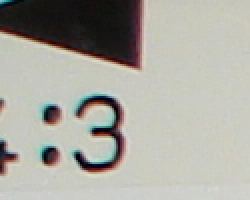 |
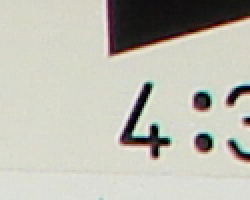 |
| Wide: moderate and bright, top left | Wide: moderate and bright, top right |
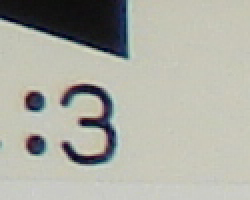 |
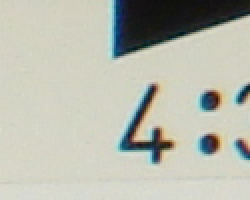 |
| Tele: quite low, top left | Tele: higher and bright at top right |
Chromatic aberration is moderate at wide angle, showing about 3-4 pixels of moderately bright coloration on either side of the target lines, but increases slightly at telephoto focal lengths, particularly in the top right of the frame. (This distortion is visible as a very slight colored fringe around the objects at the edges of the field of view on the resolution target.)
Corner Sharpness
Some softening in the left and right corners of the frame, strongest effect in the lower left corner.
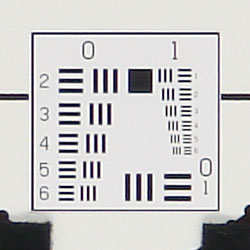 |
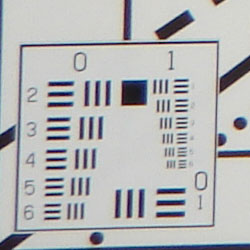 |
| Center shot is somewhat soft | Chromatic aberration and coma show up most significantly in the lower left |
The Sony DSC-T5 produced soft corners in a few shots, though the lower left corner seemed to have the most visible effect. Compare the center shot above left, which technically should be the sharpest the camera can produce, to the shot at right, which represents the softest corner of the frame.
Sensor
Exposure and White Balance
Indoors, incandescent lighting
Strong warm cast with both Auto and Incandescent white balance settings, though slightly better performance with Incandescent. About average exposure compensation required.
| Auto White Balance +1.0EV | Incandescent WB +1.0EV |
Color balance indoors under incandescent lighting was just a bit warm and orange in Auto white balance mode, though the Incandescent setting resulted in a lesser warm cast with more pleasing results. The Sony T5 required a +1.0 EV exposure compensation boost to get a good exposure, which is about average for this shot. Still, the bright highlights on the white shirt are a bit hot. The warm cast results in a purplish tint in the blue flowers, and overall color is fairly dark. (A very common outcome for this shot.) Our test lighting for this shot is a mixture of 60 and 100 watt household incandescent bulbs, a pretty yellow light source, but a very common one in typical home settings here in the US.
Outdoors, daylight
Fairly good color balance, though a hint cool. High contrast limits shadow and highlight detail.
| Auto White Balance, Auto Exposure | Auto White Balance, +0.7 EV |
Outdoor shots generally showed accurate exposure with strong, blown out highlights, and very deep shadows with limited detail. Exposure accuracy overall was better than average, the camera requiring less exposure compensation than we're accustomed to seeing with consumer digital cameras
See full set of test images with explanations
See thumbnails of all test and gallery images
Resolution
High resolution, 1,250 - 1,300 lines of strong detail.
Our laboratory resolution chart revealed sharp, distinct line patterns down to about 1,300 lines per picture height horizontally, though to about 1,250 lines vertically, with extinction at around 1,600. (The camera did produce slight color artifacts at lower line frequencies though, visible in the full-sized res target shots.) Use these numbers to compare with other cameras of similar resolution, or use them to see just what higher resolution can mean in terms of potential detail. Beware that while you might be able to make out what looks like distinct lines at numbers higher than those we've mentioned here, the camera is just doing its best to continue interpreting the lines. If you zoom in and follow them from the wider portions, you'll see the lines converge and reappear several times, so the lines you see at 1,500 and higher are really only artifacts generated by the camera's imaging system.
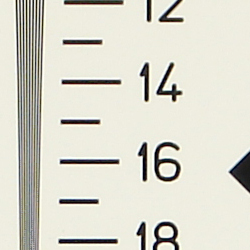 |
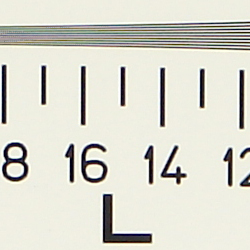 |
| Strong detail to 1,300 lines horizontal | Strong detail to 1,250 lines vertical |
See full set of test images with explanations
See thumbnails of all test and gallery images
Sharpness & Detail
Slightly soft images, with blurring of fine detail from noise suppression.
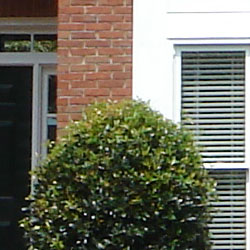 |
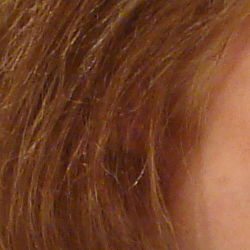 |
| Decent contrast, but slightly soft for a Sony digicam. | Subtle detail: Hair Noise suppression tends to blur detail in areas of subtle contrast, as in the darker parts of Marti's hair here. |
The Sony DSC-T5's images are slightly soft overall, escaping any strong over-sharpening or edge enhancement on the camera's part. (Edge enhancement creates the illusion of sharpness by enhancing colors and tones right at the edge of a rapid transition in color or tone.)
Noise-suppression systems in digital cameras tend to flatten-out detail in areas of subtle contrast. The effects can often be seen in shots of human hair, where the individual strands are lost and an almost "watercolor" look appears. The crop at far right shows this, with darker areas of Marti's hair showing only limited detail, even though individual strands are quite visible against her cheek in the uncropped image. (The level of detail loss shown here isn't all that obvious on prints 8x10 inches or smaller though.)
ISO & Noise Performance
Moderate noise at the normal sensitivity settings, very high noise that blurs detail at the higher settings.
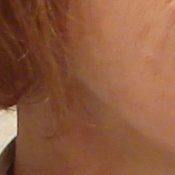 |
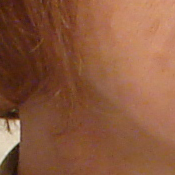 |
| ISO 64 | ISO 100 |
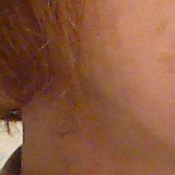 |
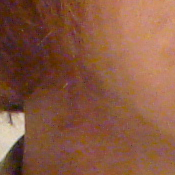 |
| ISO 200 | ISO 400 |
The Sony DSC-T5's lower ISO settings produced moderate noise, with only slightly blurred detail in the darker areas. Noise level increases with the ISO setting, resulting in stronger blurring, especially at ISO 400. Noise pixels are also fairly bright, altering the appearance of the overall color.
Extremes: Sunlit and low light tests
High resolution with good overall detail, though very high contrast and limited shadow detail. Limited low-light performance, not capable of capturing bright images under average city street lighting.
| +0.3 EV | +0.7 EV | +1.0 EV |
Sunlight:
Because digital cameras are more like slide film than negative film (in that they tend to have a more limited tonal range), we test them in the harshest situations to see how they handle scenes with bright highlights and dark shadows, as well as what kind of sensitivity they have in low light. The shot above is designed to mimic the very harsh, contrasty effect of direct noonday sunlight, a very tough challenge for most digital cameras. (You can read details of this test here.)
The Sony DSC-T5 had a little trouble with the deliberately harsh lighting in the test above, producing very high contrast with washed-out highlights and deep shadows. Noise suppression is visible in both shadows and highlights as well, contributing to the loss of detail, made more severe in these areas. At +0.3 EV, the overall exposure is a hint dark, even with the super-bright highlights. I chose the +0.7 EV exposure because of the brighter overall appearance, though I'd recommend toning down the contrast with the camera's Low Contrast setting. (In "real life" though, be sure to use fill flash in situations like the one shown above; it's better to shoot in the shade when possible.)
Low light:
Our low light testing revealed strong limitations in the lens and sensor's ability to gather and process light, meaning you'll likely need the flash for shots starting around twilight. With a maximum shutter speed of two seconds, I'd expect slightly better performance at the one foot-candle light level (about the equivalent of average city street lighting at night). The target is visible here, but only just. Color balance was pink from the Auto white balance setting. The camera's autofocus system worked well enough for the T5's usage, able to focus on the subject down to just about the 1/4 foot-candle light level (about 1/4 as bright as city street lighting) unassisted. With the AF assist lamp on, the AF system worked very well down to the lowest light level.
| 1 fc 11 lux |
1/2 fc 5.5 lux |
1/4 fc 2.7 lux |
1/8 fc 1.3 lux |
1/16 fc 0.67 lux |
|
| ISO 64 |
2 sec f3.5 |
2 sec f3.5 |
2 sec f3.5 |
2 sec f3.5 |
2 sec f3.5 |
Color
Saturation & Hue Accuracy
Slightly dark overall color, though some oversaturation in the reds and blues.
The other important part of color rendition is hue accuracy. Hue is "what color" the color is. Here, the Sony DSC-T5 performed fairly well. Blues were typically dark and purplish, and overall color balance slightly warm and yellow, though results were still quite passable.
Our random "Gallery" shots showed good color across a wide variety of subjects. (See our Sony Cyber-shot DSC-T5 Photo Gallery for more shots taken with the camera.)
Viewfinder
Coverage
Very good accuracy from the LCD monitor.
| 38mm eq., LCD monitor | 114mm eq., LCD monitor |
The T5's LCD monitor showed about 99% frame accuracy at wide angle, and close to 100 percent frame accuracy at telephoto (my standard measurement lines were just out of frame in the final shot at full telephoto).
Flash
Coverage and Range
The T5's small flash has a limited range, produces a slight blue cast in combination with typical incandescent room lighting. Our standard shots required more exposure compensation than average.
| 38mm equivalent | 114mm equivalent |
| Normal Flash, High Intensity | Slow-Sync Flash, High Intensity |
Flash coverage was just slightly uneven at wide angle but very low at telephoto. In the Indoor test, the flash on the T5 underexposed our subject at its default setting, requiring the camera's High Intensity flash adjustment to get bright results. The camera's Slow-Sync flash setting produced slightly brighter and more even results at the same High Intensity setting, though with a stronger orange cast from the room lighting.
Even at eight feet, our closest test range, flash intensity was very low. Results were quite dark at the furthest test distance.
| 8 ft | 9 ft | 10 ft | 11 ft | 12 ft | 13 ft | 14 ft |
| 1/50 sec f4.4 ISO 64 |
1/50 sec f4.4 ISO 64 |
1/50 sec f4.4 ISO 64 |
1/50 sec f4.4 ISO 64 |
1/50 sec f4.4 ISO 64 |
1/50 sec f4.4 ISO 64 |
1/50 sec f4.4 ISO 64 |
Output Quality
Print Quality
Good print quality, great color, very usable 11x14 inch prints. ISO 400 images are very soft at 8x10, acceptable at 5x7, great at 4x6.
Testing hundreds of digital cameras, we've found that you can only tell just so much about a camera's image quality by viewing its images on-screen. Ultimately, there's no substitute for printing a lot of images and examining them closely. For this reason, we now routinely print sample images from the cameras we test on our Canon i9900 studio printer, and on the Canon iP5000 here in the office. (See the Canon i9900 review for details on that model.)
With the Sony T5, we found that it had enough resolution to make very crisp 8x10 inch prints. At 11x14, its prints were a bit softer, but more than adequate for wall or table display. At high ISO, image noise levels are held in check, but detail is lost due to heavy anti-noise processing common with Sony digicams. ISO 200 photos look OK printed at 8x10 inches, but ISO 400 ones are marginal even at 5x7 inches, but look fine at 4x6. Color-wise, the Sony DSC T5's images looked really great when printed on the i9900, with bright, vibrant color.
Timing and Performance
Sony DSC-T5 Timing
Good to average speed for a consumer camera.
| Startup/Shutdown: | |
|
Power On to first shot |
1.3 seconds |
| Shutter response (Lag Time): | |
|
Full Autofocus Wide |
0.24 second |
|
Full Autofocus Tele |
0.35 second |
|
Prefocused |
0.012 second |
| Cycle time (shot to shot) | |
|
Normal large/fine JPEG |
1.00 seconds |
|
Flash recycling |
4.5 seconds |
|
Continuous mode |
0.70 second 1.43 frames/second (9 large/fine frames) |
|
Download speed |
|
|
Windows Computer, USB 2.0 |
5,247 KBytes/sec |
The T5's performance is pretty good, with fairly fast startup and shutter response times. The lag time of 0.24 second is quite fast at wide angle, and if you "prefocus" the camera by half-pressing and holding down the shutter button before the final exposure, it's blazingly fast, with a shutter delay of only 0.012 second, among the fastest on the market. Shot to shot cycle times are pretty good as well, at about 1.0 seconds for large/fine JPEGs. Continuous-mode speed is slightly slow however, at a bit over one frame/second, for up to nine shots in succession. The flash takes about 4.5 seconds to recharge after a full-power shot, a little higher than average for this class of camera.
Battery and Storage Capacity
Battery
Excellent battery life for a subcompact.
|
|
|
| Still-image capture mode LCD on |
128 minutes |
| Image playback LCD on |
234 minutes |
The Sony DSC-T5 uses a Sony NP-FT1 3.6V 2.4Wh LiIon battery for power. We were unable to test the actual battery drain, but we've found Sony's own InfoLITHIUM system reports battery runtime estimates with pretty good accuracy, so we've filled in what the camera says it expects after a full charge.
Storage
No card is included with the Sony Cyber-shot DSC-T5, although it accepts Sony Memory Stick Duo and Duo PRO memory cards; 32MB RAM is built into the camera.
|
32MB Internal Memory |
Fine | Normal | |
| 2,592 x 1,944 | Images | 12 | 22 |
| File Size | 2.6MB | 1.4MB | |
| 2,048 x 1,536 | Images | 19 | 34 |
| File Size | 1.6MB | 924K | |
| 1,280 x 960 | Images | 46 | 85 |
| File Size | 684K | 376K | |
|
|
Images | 187 | 467 |
| File Size | 171K | 68K | |
I strongly recommend buying at least a 128MB card, preferably a 256MB one, to give yourself extra space for extended outings.
| Pro: | Con: |
|---|---|
|
|
Sony's Cyber-shot line of digital cameras has consistently proven itself to be versatile and excellent in quality, providing constant innovation in the digital camera marketplace. The DSC-T5 offers yet another exciting digicam option, with its tiny size and wealth of features. I love the return of the big sliding lens cover, something the T33 lacks; but it's not quite a slick as the T1's slider in either feel or appearance . The 5.1-megapixel CCD is an outstanding feature in a camera this small, and the large LCD monitor is impressive as well. The DSC-T5 shows good image quality, with good color, and high resolution. Its image sharpness and noise levels aren't quite up to the level of the best full-sized 5-megapixel cameras out there, but they're good for a subcompact model. We did find that the lens quality was better than the T33 we reviewed. Relative to competing full-sized digicams the T5 does have limited low-light capability and limited flash power, but that's expected in a camera of this size. The DSC-T5's flexible exposure modes and features make the camera able to handle just about any situation. The camera's light weight and portable size are perfect for travel. Though we haven't seen much change from the T1 to the T5, it's still a very impressive camera in a very small package.
Free Photo Lessons

Simple pro lighting and use tips let you snap stunning photos. Check out our free Photo School area!
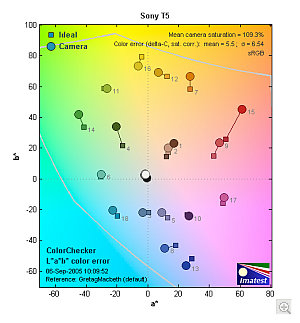

Follow Imaging Resource: